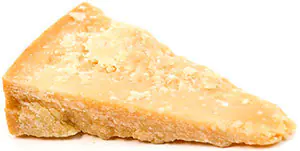Another representative of Italian cuisine is Parmesan cheese (Latin: Parmigiano Reggiano). It belongs to hard cheeses. Its production first began in the two Italian provinces of Parma and Reggio Emilia, which is how it got its name. And all this happened more than three hundred years ago. The history of creation began with the fact that Italian monks invented a new type of cheese that could be stored longer than others.
Its preparation is made from cow's milk, of which a very large amount is taken so that the product ends up dense and dry. Imagine the proportions: to produce 1 kg of the target product, 16 liters of cow's milk will be required. Basically, preparation occurs during three seasons: spring, summer and autumn. And after that there are another 36 months for final maturation. During this time, after the cheese wheel is formed, it is checked after the first six months of storage in the molds. Parmesan undergoes the strictest selection to meet all quality criteria. If any of them does not match, it is rejected. For example, this can happen if too much air has accumulated in the mold or the cheese mass is uneven.
After strict selection, the finished food matures for another year. At the end of the cooking process, the cheese wheel is stamped with the Denominazione di Origine Protetta, confirming its originality and quality. And on the shell itself you can see many small holes, ultimately forming the coveted inscription Parmigiano Reggiano.
The cheese wheel of this famous representative of Italian cuisine is far from small, its weight reaches 40 kilograms. Because of this, it is always sold prepackaged.
Parmesan is one of the most popular types of cheese. It is impossible to imagine Italian pizza and pasta without it; it perfectly complements the taste of Mediterranean risotto. Along with this, it can be eaten as a separate snack. Its rich tart taste is perfectly complemented by nuts or fruits.
Post Views: 147


